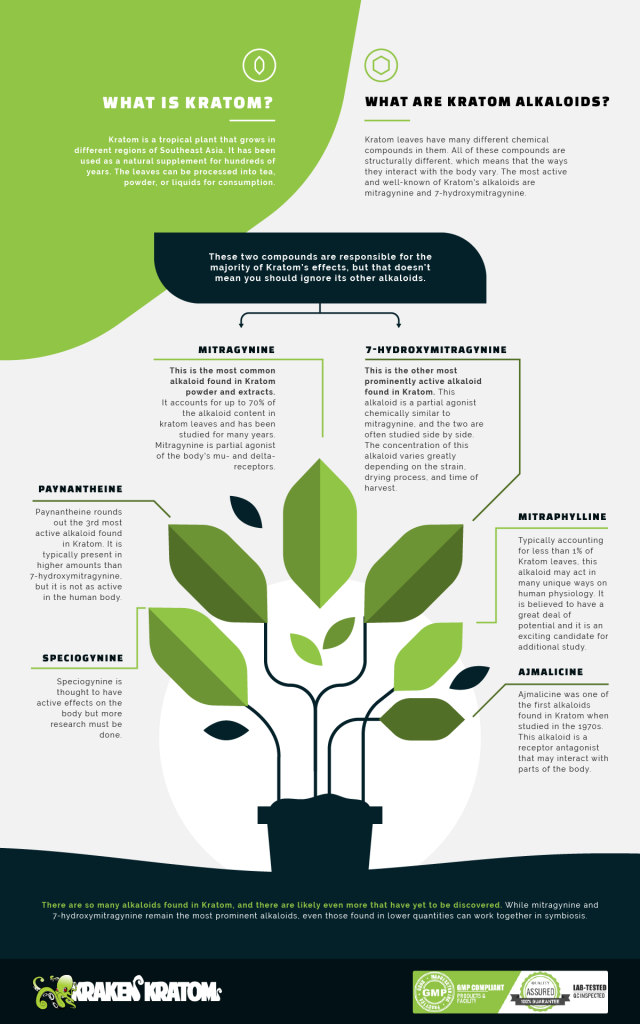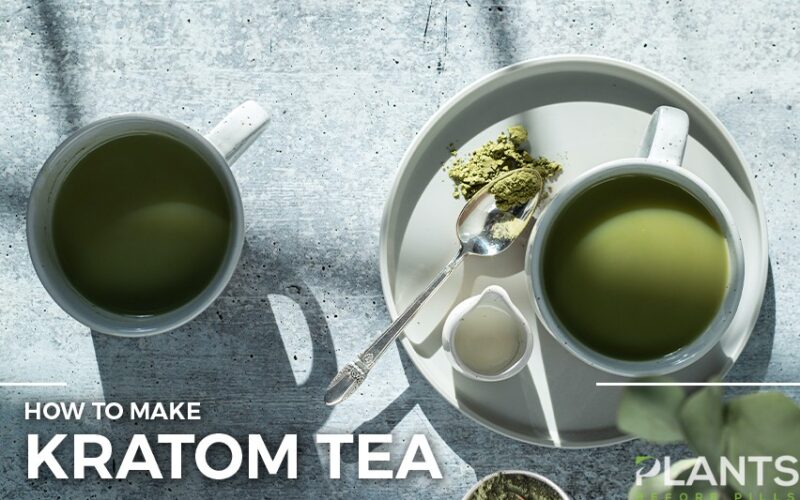While many people are learning more about Kratom and its potential, not as many are familiar with its chemical components. Getting a basic understanding of these components is a worthwhile endeavor. After all, the benefits that Kratom consumers report are directly related to its chemical composition! Before you buy Kratom online, it’s important to gain an understanding of how it works.
Studies about Kratom and how it affects the body have been centered around its alkaloids. Kratom alkaloids, which are naturally occurring compounds found in many plants, interact directly with the body, so understanding them gives a better understanding of Kratom in a more general sense.
Many people are familiar with Kratom’s main alkaloid, mitragynine, and maybe even with 7-hydroxymitragynine, which occurs in much smaller concentrations. But there are actually dozens of alkaloids in the Kratom plant. What are these alkaloids, and what do we know about them?
What Is Kratom?
Kratom is a tropical plant that grows in different regions of Southeastern Asia. The leaves from this tree are harvested in Thailand, Borneo, Malaysia, and other countries and then dried. The dried leaves can be used as a natural supplement, and they have been used this way for hundreds of years in these areas.
The leaves can be processed into tea, powder, or liquids for consumption. Kratom enthusiasts around the world use Kratom while seeking relief for a variety of symptoms.
What Are Kratom Alkaloids?
Kratom leaves have many different chemical compounds in them. All of these compounds are structurally different, which means that the effects they have on the body vary. The most well-known effects of Kratom are thought to be caused by mitragynine and 7-hydroxymitragynine.
These two compounds are only two of the many Kratom alkaloids that can be found in Kratom leaves. They are the most prominent because they bind the most readily with the body’s receptors, but that doesn’t mean that the other Kratom alkaloids should be ignored.

Breaking Down Kratom Alkaloids
To understand the potential of Kratom and products derived from it, let’s break down some of the alkaloids found in Kratom.
Mitragynine
One of the two most common alkaloids found in Kratom is mitragynine. Mitragynine is usually the primary alkaloid in Kratom. It accounts for up to 70% of the alkaloid content in Kratom leaves, and it has been studied in isolation for many years. It binds readily with important receptors in the body, which accounts for its reported effects.
7-hydroxymitragynine
This is the other most prominently active alkaloid found in Kratom.
7-hydroxymitragynine chemically similar to mitragynine, so it is often studied in relation for the reasons and in the same contexts. The amount of 7-hydroxymitragynine in Kratom leaves varies much more than that of mitragynine, though. The amount is dependent on the variety, drying procedure, and time of harvest but is always quite small, typically just fractions of a percent.
Paynantheine
Paynantheine is the Kratom alkaloid that makes up the second-highest amount of chemical compounds in the Kratom leaves. It is typically present in higher amounts than 7-hydroxymitragynine, but it is not as active in the human body. More research needs to be done about this alkaloid, but there is some information available at this time.
Speciogynine
The alkaloid with the third-highest concentration in most Kratom leaves is speciogynine, another alkaloid that is thought to have active effects in the human body. More research needs to be done about this substance as well.
Mitraphylline
Typically accounting for less than 1% of Kratom leaves, this alkaloid may act in many unique way on human physiology. Mitraphylline is believed to have a great deal of potential and it is an exciting candidate for additional studies.
Ajmalicine
Ajmalicine was one of the first alkaloids found in Kratom when studied in the 1970s in Southeastern Asia. This alkaloid is a receptor antagonist that may interact with parts of the body that regulate various functions.
Many, Many More
There are so many alkaloids found in Kratom leaves, and there are likely even more that have yet to be discovered. While those with the highest concentrations have the most direct effects through Kratom, even those with lower quantities can act in symbiosis with other alkaloids. More studies will need to be done to see if the alkaloids function with each other.
It will be very interesting to find out how much that is the case. In the case of CBD and cannabis products, it has been found that many chemical components of cannabis actually work together to have more profound effects on the body, sometimes called the entourage effect. Whether or not the same can be said about Kratom components is yet to be seen.
Studying Kratom Alkaloids
As you worked through the list of some of the 40+ alkaloids found in Kratom above, you likely noticed that many of the alkaloids have not been thoroughly researched.
Because the amounts of alkaloids in leaves vary so greatly, studying them individually needs to be done sooner rather than later. Alkaloid content in leaves varies based on geographic location, harvest time, technique, and much more.
If science makes it so that we have a better understanding of individual alkaloids and their effects on the body, we would be better able to diversify and understand different Kratom strains. We already know that the leaves’ strain color, for example, can possibly be linked to alkaloid content breakdown.
According to a study from the 1970s, the alkaloids found most frequently in one area were:
Mitragynine
Speciogynine
Speciociliatine
Paynantheine
Ajmalicine
C9 methoxy-oxindoles
When looking at other strains and other geographic locations, however, this breakdown varied tremendously. Many studies that did not analyze the alkaloid breakdown of Kratom may not equally apply to all strains, and that is a problem.
As we move forward with Kratom studies, we know how important it will be for individual alkaloids to be analyzed. There is a diverse world of alkaloids in the leaves of Kratom, and there may be great benefits hidden in those alkaloids.
Looking Forward With Kratom Alkaloids
While mitragynine and 7-hydroxymitragynine remain the most prominent and well-studied components of Kratom, there are many other alkaloids that may provide some real benefits. As we move forward, we can expect to see more research done about those components. Not only will they be useful in Kratom as a whole, natural substances, but those alkaloids could be developed into additional substances as well.
Only time and additional research will be able to show the true potential of Kratom alkaloids!
Kraken Kratom is a premier online vendor of high-quality Kratom products. They offer a wide variety of the most popular Kratom strains including Bali, Maeng Da, Gold Reserve, and others.
Medical Disclaimer:
The information provided in these blog posts is intended for general informational and educational purposes only. It is not a substitute for professional medical advice, diagnosis, or treatment. Always seek the advice of your physician or other qualified healthcare provider with any questions you may have regarding a medical condition. The use of any information provided in these blog posts is solely at your own risk. The authors and the website do not recommend or endorse any specific products, treatments, or procedures mentioned. Reliance on any information in these blog posts is solely at your own discretion.







